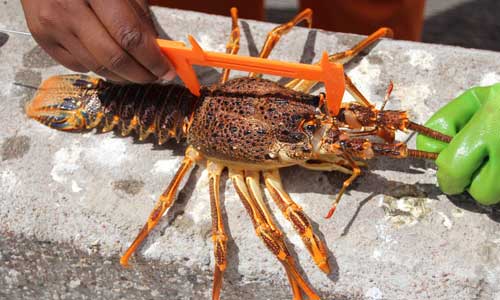Linking Socio-economic and Ecological Systems: Long-term Monitoring of Small-scale Fisheries Along the South African Coastline
By Denise M. Mager, Mafaniso Hara, Mzamo Maqebaa and Abongile Ngqongwa
Human dependence on marine and coastal resources is increasing. In South Africa and around the world, small-scale fisheries are envisioned to contribute towards human well-being and economic development (1,2). In particular, South Africa’s small-scale fisheries policy states the role of the sector as being economic development and food security through poverty alleviation, job creation livelihoods and food security (1). The means for addressing this vision strongly lie in the strengthening of the profile of the sub-sector and protecting its assets; establishing the sub-sector’s appropriate place within fisheries as a whole; and establishing the role of small-scale fisheries within other economic and development sectors.
A national incentive for the management of small-scale fisheries is thus recognized as an essential tool for maintaining the nutritional status of low-income households. Elucidating trends in catch rate and composition is also important to evaluate the impact of fishing on fish stocks, and thereby guide fisheries management action.
|
|
The Department of Agriculture, Forestry & Fisheries (DAFF) manages the Small-Scale commercial fisheries of South Africa under the authority of the Marine Living Resources Act Amendment Bill (3). The Department started a process of collecting fisheries data so that management is informed and able to take appropriate actions (e.g. number of fishing permits issued within a community). In order to create a fisheries management information system, DAFF joined forces with the national Expanded Public Works Programme (EPWP) providing work opportunities to women, youth and the disabled. Together, DAFF and EPWP set up a national, provincial and local government initiative to elucidate daily catch and composition of small-scale fisheries whilst creating sustainable jobs to transform economic resources.
In 2011, Jaymat Enviro Solutions (under contract from DAFF) started the process of collecting fisheries data. Key objectives of the programme include: job creation, skills transfer and to collect critical fisheries catch-data across three regions, covering a majority of the coastline. Local youth is employed from the adjacent communities and adequately trained to fulfill the programme objectives of accurate data collection. Given the geography of South Africa, fishing activities varies across the regions. The Eastern Cape coast is rugged with interspersed beaches populated by small communities depending on informal fishing (e.g. anglers). The coastline along the Western and Northern Cape hosts small towns with formal infrastructure for fishing such as landing slips and harbours, giving priority to fishing activities with boats of varying sizes. Data includes total fishing effort (number of boats or fisherman on the coast), fishing permit, bait and fishing gear used. Species monitored include line-fish, oysters, mussels, abalone and West Coast and East Coast rock lobster and the data collected not only includes total number of fish caught but also biological information such a length, weight and sex where appropriate.
The responsibilities of the catch data monitors includes undertaking routine patrols by means of foot to determine total fishing effort, assisting compliance with the issue of invoice slips (line fish and West Coast rock lobster) and gather information directly from the fishermen. Once the data is collected in the field, the data is then captured in electronic format. In one of the regions alone (Eastern Cape), the fishing effort is measured across 54 sites producing up to 4,000 monthly data entries, showing the importance of monitoring fisheries on a daily basis.
|
|
Part of fulfilling the vision for small-scale fisheries requires establishing and demonstrating socio-economic benefits that are derived from the sector for fishers, fishing communities and other stakeholders, and also raising the profile of this new sector. This will require collection and analysis of socio-economic data and information for inputting into the decision support tools and systems for policy and decision makers. In future therefore, it will be an important requirement to collect such information in addition to the biological information being currently collected. This would also fulfill an ecosystems approach to fisheries management (4), which South Africa adopted in 2002.
This programme is evidence that national incentives can provide appropriate management tools and policies for the sustainable use of common natural resources supporting food security and livelihoods. Monitoring catch and composition not only elucidates resource fluctuations, but also, species monitored will allow for responsible management and conservation of resources.
References
1. Department of Agriculture, Forestry and Fisheries. (2012). Policy for the Small-scale Fisheries sector in South Africa. Government Notice No 474, 20 June 2012. Republic of South Africa Government Printers
2. FAO/RAP/FIPL. 2004. A research agenda for small-scale fisheries. FAO Regional Office for Asia and the Pacific, Bangkok, Thailand. RAP PUBLICATION No. 2004/21 and FIPL/C 10009 (En) 42 pp.
3. RSA (Republic of South Africa). 2013. Marine Living Resources Act (No. 18 of 1998) amendment bill (B 30B—2013). South Africa.
4. Shannon LJ, Cochrane KL, Moloney CL, Freon P. 2004. Ecosystem approaches to fisheries in the southern Benguela: a workshop overview. In: Shannon LJ, Cochrane KL, Pillar SC (eds), Ecosystem approaches to fisheries in the southern Benguela. African Journal of Marine Science 26: 1–8.
Denise M. Mager, Mafaniso Hara, Mzamo Maqebaa and Abongile Ngqongwa of the JAYMAT Enviro Solutions in Cape Town, South Africa.

